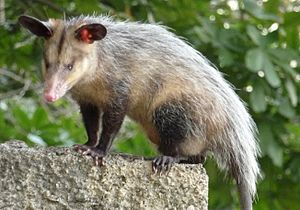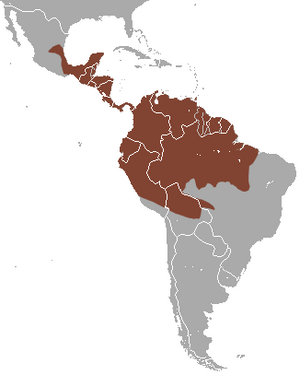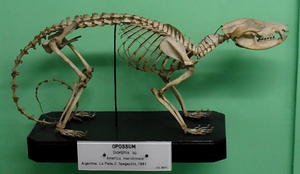Common opossum facts for kids
Quick facts for kids Common opossum |
|
|---|---|
 |
|
| In an urban area of Caracas, Venezuela | |
| Conservation status | |
| Scientific classification | |
| Genus: |
Didelphis
|
| Species: |
marsupialis
|
 |
|
| Common opossum range | |
| Synonyms | |
|
Didelphis marsupialis marsupialis |
|
The common opossum (Didelphis marsupialis) is a fascinating marsupial. It's also known as the southern opossum or black-eared opossum. Sometimes people just call it a possum. These animals live in many places, from Mexico all the way down to Bolivia. You can also find them in Trinidad and Tobago and other Caribbean islands. In some places, like the Caribbean, they are called manicou. Opossums love forests, but they can also live in fields and even cities!
Contents
Where Opossums Live
Common opossums live in warm, wet forests. You can find them in both old and new forests. They live at different heights, up to 2200 meters (about 7,200 feet) high.
Opossum Homes
Opossums are clever about where they make their homes. They often choose hollow trees. If a tree isn't available, they might dig a burrow. They will also nest in any dark, safe spot they can find. Opossums like to den underground, especially when it's not the dry season.
What Opossums Look Like
The common opossum is about the size of a house cat. Its fur looks black, but underneath it's yellow. Their tail, fingers, and face are lighter in color. The tail has no fur, looking a bit like a giant rat's tail.
An opossum can be nearly 20 inches long. It has large ears that are usually black. Its face is often a pale peach color. It has black whiskers and eyes that glow reddish in the dark. With a body almost a foot long and a tail nearly two feet, it's one of the bigger opossums. An adult can weigh more than three pounds.
How Opossums Behave
Opossums are mostly active at night. They usually walk on the ground. But they also climb trees to explore and nest. They are usually alone, except when they are mating.
Male opossums travel more at night during wet seasons. Female opossums stay closer to home when they are raising babies. Males are busiest between 11 PM and 3 AM.
Sometimes, opossums act a bit like raccoons. They might raid trash cans or nest in places like garages. If they get into a human living space, they can cause a mess. People often try to trap them. Opossums do not protect their territory.
Playing Dead
When opossums feel scared, they have a special trick. They act like they are dead! This is called 'playing opossum'. This trick often makes predators lose interest.
What Opossums Eat
Common opossums can eat many different things. Their teeth help them chew all sorts of food. They usually find their food on the ground.
They eat:
- Insects like beetles and grasshoppers
- Other small creatures like earthworms
- Small animals like toads, snakes, birds, and small mammals
- Fruits and vegetables
- Nectar
- Dead animals (carrion)
In cities, they might find food in compost piles or garbage cans. They can digest almost anything edible. This helps them find food in many places.
How Opossums Reproduce
Female opossums can have 5 to 9 babies. They might have babies one to three times a year. The mother raises the young by herself. Opossums can mate for most of the year. They do not stay with one partner for life. A female can give birth to up to 24 babies at once. However, usually only about a third of them survive. Young opossums stay with their mother for a few months. They become adults before they are one year old.
How Long Opossums Live
The common opossum usually lives for about 2 to 4 years.
Opossum Family Tree
Common opossums belong to the group Didelphis. This group includes the largest opossums in the Americas. They are also part of the order Didelphimorphia. All opossums in the Western Hemisphere belong to this order. The common opossum is not an endangered species right now.
See also
 In Spanish: Zarigüeya común para niños
In Spanish: Zarigüeya común para niños



